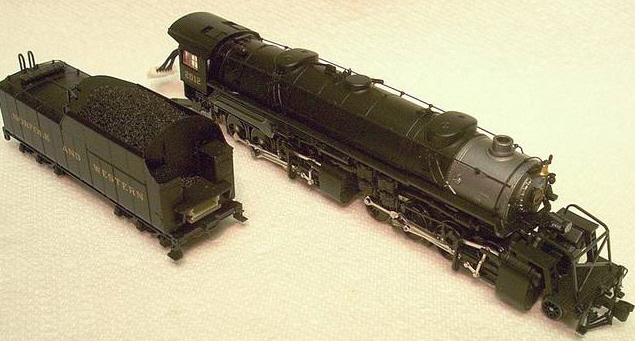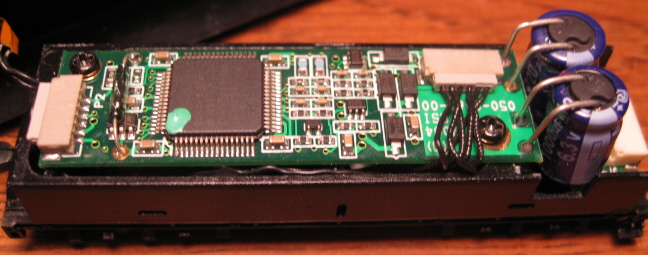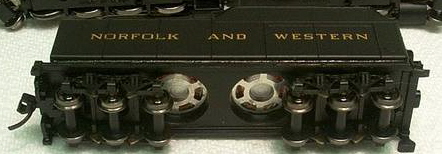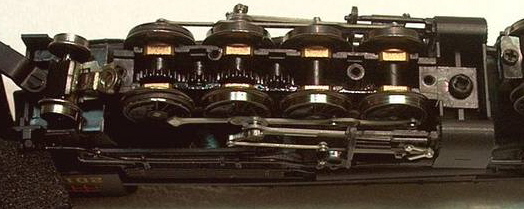



Introduced: 2002 (non-DCC version) and 2008 (DCC/Sound version)
These locomotives are part of the Life-Like "Heritage Steam Collection" and they are gorgeous pieces of modeling. Detailing is stunning and performance is quite impressive (in fact, the initial release was voted Model Railroader "N Scale Locomotive of the Year" for 2002) . As noted above, there are two distinctly different versions of this model. The initial release lacked any sort of support for DCC and did not come with traction tires or automatic couplers. The revised (2008) version is fully DCC-Ready, has traction tires, and comes equipped with a factory-installed Accumate coupler on the tender. In 2018, Atlas purchased the tooling for the Life-Like/Walthers line of N scale models (including this 2-8-8-2). So, it's possible that there may yet be another production run.
On the first release, all motor current is provided by the drivers (with all 16 of them providing pickup). The pilot and trailing trucks are electrically neutral. The tender wheels do collect current, but there is no electrical connectivity between the locomotive and the tender (the tender pickup being solely for the backup light).

The chassis is mostly metal. Unfortunately, it is not split-frame (IE, current is ferried around via wires rather than the chassis itself). The motor is an open-sided / skew-wound 5-poler with dual flywheels. Apart from the metal worms, all gearing is plastic. Only one set of drivers per engine is geared (with all the rest of the wheels being turned by the running gear). Directional lighting is provided by PC boards mounted at the front of the locomotive chassis and inside the tender. The locomotive headlight is actually mounted on the pilot assembly (with wires running back to the PC board). The pilot coupler is a dummy (non-operational) knuckle. The tender coupler is a shell-mounted Rapido (although MT conversion is simple as the tender has been provided with a pre-drilled hole for screwing in an MT coupler assembly). The wheels are low-profile, so no problems on Code-55 rails.
These first run models are very smooth, very quiet and perform flawlessly at all speeds. Slow speed creep is superb. For such a lengthy steamer, it has no problems at all with the narrow, twisting curves on my "Scenic Ridge" layout. And whereas some big steamers look pretty silly navigating my layout, this one actually looks damned pretty snaking around all those curves. Better still, I've run this thing around in circles for hours and never had any of the wheels jump the rails (always a hazard with steamers it seems, especially with the pilot and trailing trucks).
The main gripe with the first-run Mallets is that they are not exceptional pullers. There's a lot of empty space inside the engine, so it's a bit lighter than it could be. And without any traction tires, it doesn't pull much more than your average small diesel model. Mine can handle about 20 cars on flat track and maybe 8 cars up a 2% grade. So, not horrible, but quite a bit less than one would expect from a big ol' Mallet.
And although a minor quibble, I must register my annoyance with the drawbar connection between the engine and tender. It's one of those "stick the peg on the tender into the hole on the drawbar" type deals. And trying to keep the things coupled while simultaneously trying to get all of the wheels on the track is always a frustrating ordeal. I thought we'd dispensed with this annoying system back in the 1980s!
The good news is that Life-Like addressed most of my gripes with the revised 2008 release -

As mentioned above, it is fully DCC-Ready. In fact, it is available with a factory-installed sound decoder in the tender -


The decoder is a "QSI Quantum", and it's really quite astounding. It has all of the bells and whistles one normally associates with sound decoders (pun fully intended), in addition to some interesting new wrinkles. I really like its "voice feedback" feature. When re-programming CV values "on the main", the speakers literally tell you what you've just done ("CEE VEE FIVE ONE EQUALS TWO THREE"). The decoder is "dual mode", meaning that these models will run on both DC and DCC layouts. And even in analog mode, most of the sound features are available using a standard DC powerpack. However, should you wish to have all the various sound affects available to you, you'll need to get a special piece of hardware (a "Proto 2000 Quantum Engineer Controller"). Sound is provided by two speakers mounted inside the tender and is, for N scale, pretty impressive (although I must admit, the novelty factory of locomotive sound is wearing a bit thin with me).

The instruction booklet included with the loco covers the basics of decoder operation. But if you want the whole story (all 200+ pages worth), a downloadable manual is available from Walthers.
The revised Mallet is also available simply "DCC Ready". These have an 8-pin NMRA decoder plug in the tender as well as a wiring harness between locomotive and tender (the same harness used on the decoder-equipped models). The loco-to-tender connection means that tender current pickup is now transferred to the motor (not that the first version had any pickup problems, but still). The DCC-Ready version (IE, the one without a preinstalled Quantum decoder) does not have the speaker holes in the tender.
In addition to all the DCC stuff, the other major change in this second version is the addition of a second geared driver pair in the rear truck -

Better still, the rearmost pair of drivers now comes with factory-installed traction tires. An ala-carte driver pair (sans traction tires) is also included should you wish to swap out the traction tire drivers and have your Mallet pull less(?) Pulling power is much improved over the first release, with reports of people being able to pull as many as fifty cars (and more) with this revised version.
Overall performance on this second version is every bit as good as the first version. The only problems I've run into is with the wiring harness between the locomotive and tender. If you don't get it "just right", it can mess with the forward tender truck and cause it to derail on curves. But if that happens, it's just a matter of rejiggering the wires into a different position. At this point I don't know what the "perfect arrangement" might be - I just play around with it until I get something that works. Unfortunately, the drawbar connection on the tender is still annoying. But hey, I guess you can't have everything.
Prototype Information: -
First built for the Southern Pacific in 1909 to tame its tough western grades, the 2-8-8-2 articulated Mallet soon caught the attention of roads facing similar problems. In 1910, Norfolk and Western ordered five 2-8-8-2s (Class Y-1) similar to the SP models from Baldwin. By 1918, lessons learned from the first group led to an improved version, the Y-2; with minor changes to the cylinders, these became Class Y-2a, which served as the basis for the United States Railway Administration (USRA) 2-8-8-2.
Although delivered too late for the war effort, the N&W received 50 of the USRA engines in 1919, which it classified as Y-3. In 1923 another 30 were ordered with larger tenders (Y-3a), followed by 10 more in 1927 fitted with feedwater heaters. During World War II, several Y-3s were sold to various western railroads that were desperate to ease motive power shortages. Although well suited to coal-hauling duties in the Appalachians, the big articulateds proved too slow for most of their new owners and they were retired or sold following the war. At home, Y-3s remained in service until 1958.
To remove the boiler shell, unscrew the screw inside the smokestack and the one back by the drawbar. The shell should lift right off at that point.
Grade: A (for either, although I guess a "C" for the first version if you have a lot of steep grades)
First release reviewed: 03/03 Model Railroader ("Life-Like has released a great looking model of the Norfolk & Western class Y3 2-8-8-2 that's a bit of a mixed blessing. It's a smooth runner, but it's gearing delivers an excessive scale speed... Life-Like's model closely follows prototype dimensions... The boiler and cab are molded in a sharply detailed plastic casting with more than 50 added detail parts, including metal handrails and a brass bell... Mechanically, the locomotive is similar in construction to Life-Like's HO USRA 2-8-8-2. Interestingly, the motor is mounted in the middle of the boiler with a worm on each end to power both sets of drivers... There are no traction tires... The directional headlight components are mounted on a small PC board attached to the front of the main boiler weight. While there's no provision for DCC, the motor is isolated from the frame and there's sufficient space to fit an N scale decoder in the firebox. All of the electrical pickup is through the engine wheels, so the only DCC wire between the locomotive and the tender would be the one controlling the backup light.
"The tender is also made of well detailed plastic parts and has electrical pickup through all 12 wheels. However, this current is used only for a reversible backup light controlled by another small PC board in the tender. A Rapido-style coupler is mounted on the rear of the tender... A dummy knuckle coupler is provided on the locomotive pilot... Our sample seemed a bit tight when we first tested it, but about five minutes of running loosened everything up. The starting speed was fine, and it ran smoothly in the usual slow drag freight speed range under three volts. Unfortunately, the speed curve climbs quickly once you pass three volts, to nearly three times the prototype's top speed! The drawbar pull is a bit low as it's only equivalent to about 20 cars. Of course there's nothing that says it has to run at full throttle, and watching this chunky 2-8-8-2 plodding along with a coal drag remains an impressive sight most N scale steam fans will enjoy. AT&SF, N&W, Undec $275")
DCC version reviewed: 03/09 Model Railroader ("The locomotive has a utilitarian black paint job with a graphite smokebox and firebox. The minimal yellow lettering is straight, crisp, and vivid, with even the tiny capacity lettering on the tender being readable. Other details make this model a standout, including fine piping along the boiler, rivet detail on the boiler and tender, metal handrails, and working valve gear. Removing one screw in the smokestack and one under the cab let me lift off the top of the plastic shell. Inside, a split-frame motor with dual flywheels nestled into the metal frame. Worm gears turn two axles on the rear set of drivers and one on the front set; motive power is transferred to the others via the side rods. All the drivers handle electrical pickup.
"Our sample came equipped with a dual-mode sound decoder, meaning it works both under Digital Command Control and direct-current operation. In DC, the decoder makes use of a power pack's reversing switch to trigger the whistle and bell. The decoder keeps the locomotive moving in the same direction even when the switch is flipped. The model also comes with a magnetic wand that can be used to program other effects. Placing the wand across the tender while turning the power off or on can control the master volume, turn the locomotive on or off, or return the decoder to factory settings. The model's powerful sound system features two downward-facing 1/2"-diameter speakers mounted on the tender's chassis. Both speakers are well-enclosed so there are no buzzes or rattles, even at full volume.
"Like the prototype, Walthers' 2-8-8-2 boasts a hefty drawbar pull. The model exerts a pull of 2.1 ounces, which is equivalent to 50 N scale freight cars on straight and level track. Although all the drivers have flanges, our sample easily transited a 93/4" radius curve, since both sets of drivers swivel (unlike the prototype). However, the Y3a would look best on broader curves. I tested the model first under direct current. At almost 4 volts, the sound of the steam engine started. At 9 volts, the locomotive crept along at 1.3 scale mph. At 10 volts, it reached 34 scale mph, close to the prototype's typical top speed. At 12 volts, the locomotive moved at 69 scale mph. In Digital Command Control, the model started and ran rather hesitantly at lower speed settings. This evened out somewhat when I increased the model's starting voltage (Configuration Variable 2). Switching to 128 speed steps made it easier to control the locomotive's speed in the lower ranges.
"The upgraded Walthers model is a smooth-performer, especially in DCC. With sounds appropriate for a hard-working Mallet, this N scale Y3a now sounds as good as it looks. Road names: Virginian Ry.; Atchison, Topeka & Santa Fe Ry.; Norfolk & Western; Pennsylvania RR; Union Pacific; (two road numbers each in DCC, one in DC), and undecorated versions. Price: Direct-current, $224.98; with Digital Command Control and sound, $324.98"